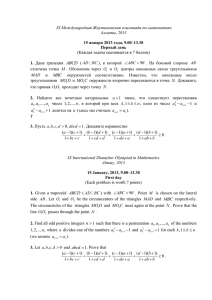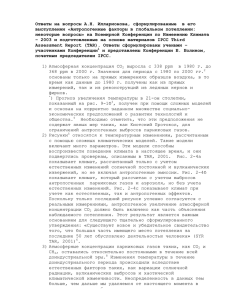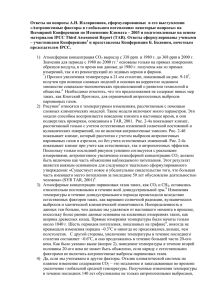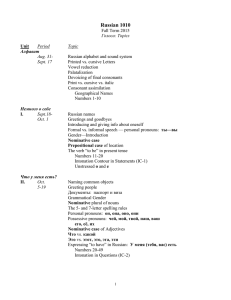Маркировка составных компонентов и выделяемых продуктов
advertisement
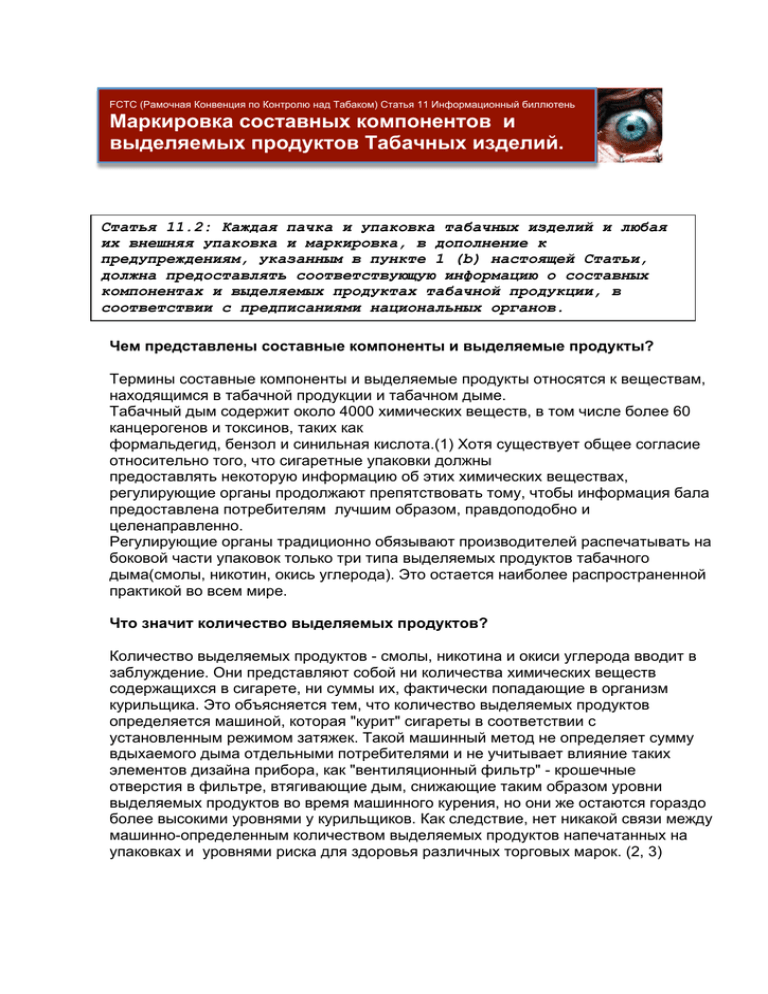
FCTC (Рамочная Конвенция по Контролю над Табаком) Статья 11 Информационный биллютень FCTC Article 11 Fact Sheet Маркировка составных компонентов и EMISSION AND CONSTITUENT LABELLING выделяемых продуктов Tабачных изделий. Article 11.2 : Each unit packet and package of tobacco products and any outside packaging and labelling of such products shall, in addition to the warnings on on relevant specified in pи aragупаковка raph 1(b) of this Artiтабачных cle, contain informatiизделий пачка и constituents and emissions of tobacco products as defined by national authorities. Статья 11.2: Каждая любая их внешняя упаковка и маркировка, в дополнение к предупреждениям, указанным в пункте 1 (b) настоящей Статьи, WHAT ARE CONSTITUENTS AND EMISSIONS? должна предоставлять соответствующую информацию о составных Constituents and emissions refer to the substances found in tobacco products and smoke. компонентах и выделяемых продуктах табачной продукции, в Cigarette smoke contains approximately 4,000 chemicals, including over 60 carcinogens and toxins, such as formaldehyde, benzene, and hydrogen cyanide. Although there is general agreement that cigarette packages should соответствии с предписаниями национальных органов. provide some information on these chemicals, regulators continue to struggle with how best to communicate this 1 information in a feasible and meaningful way to consumers. Regulators have traditionally required manufactures to print the levels of three emissions (tar, nicotine, and carbon monoxide) on the side of packages. This remains the most practice throughout the world. Чем представлены составные компоненты и common выделяемые продукты? WHAT DO EMISSIONS NUMBERS MEAN? Tar, nicotine, and carbon monoxide emission numbers are misleading. They represent neither the amount of chemicals Термины составные компоненты и выделяемые продукты относятся к веществам, present in the cigarette, nor the amounts actually ingested by human smokers. This is because the emission numbers are determined by a machine that “smokes” cigarettes according to a fixed puffing regime. This machine находящимся в табачной продукции и табачном дыме. method does not predict the amount of smoke inhaled by individual consumers or account for design elements such as “filter ventilation” – tiny holes poked in the filter that yield low emission levels under machine smoking,более 60 Табачный дым содержит около 4000 химических веществ, в том числе but much higher levels under human smoking. As a result, there is no association between the machine-generated канцерогенов и токсинов, таких numbers printed on как packages and the health risk of different brands. формальдегид, бензол и синильная кислота.(1) Хотя существует общее согласие HOW DO SMOKERS INTERPRET EMISSIONS NUMBERS? emission numbers printed on packages are the same numbers that tobacco относительно того, что сигаретныеThe упаковки должны companies have used in misleading advertising that markets “low tar” cigarettes as an alternative предоставлять некоторую информацию обto quitting. этих химических веществах, Printing emission numbers on packages reinforces this deceptive marketing campaign регулирующие органы продолжаютandпрепятствовать тому, чтобы информация бала the false belief that low tar cigarettes are less hazardous. For example: предоставлена потребителям лучшим образом, правдоподобно иthat the tar t 75% of smokers from Australia, Canada, the U.S. and the UK believe numbers on packs are related to exposure; целенаправленно. t Among smokers who believe that some brands are less harmful than others, believe that the tar andпроизводителей nicotine levels indicate brands that areраспечатывать less harmful; Регулирующие органы традиционно81% обязывают на t When shown emission labels on two cigarette brands from the European Union, боковой части упаковок только три типа выделяемых табачного 92% of smokers recently reported that theпродуктов 4mg product would deliver less tar than the 10mg product, and 90% reported that they would buy the 4mg product if they дыма(смолы, никотин, окись углерода). Это остается наиболее распространенной were trying to reduce the risks to their health. практикой во всем мире. 2,3 2,4 5 5 6 Что значит количество выделяемых продуктов? Количество выделяемых продуктов - смолы, никотина и окиси углерода вводит в заблуждение. Они представляют собой ни количества химических веществ содержащихся в сигарете, ни суммы их, фактически попадающие в организм курильщика. Это объясняется тем, что количество выделяемых продуктов определяется машиной, которая "курит" сигареты в соответствии с установленным режимом затяжек. Такой машинный метод не определяет сумму вдыхаемого дыма отдельными потребителями и не учитывает влияние таких элементов дизайна прибора, как "вентиляционный фильтр" - крошечные отверстия в фильтре, втягивающие дым, снижающие таким образом уровни выделяемых продуктов во время машинного курения, но они же остаются гораздо более высокими уровнями у курильщиков. Как следствие, нет никакой связи между машинно-определенным количеством выделяемых продуктов напечатанных на упаковках и уровнями риска для здоровья различных торговых марок. (2, 3) Regulators have traditionally required manufactures to print the levels of three emissions (tar, nicotine, and carbon monoxide) on the side of packages. This remains the most common practice throughout the world. WHAT DO EMISSIONS NUMBERS MEAN? Tar, nicotine, and carbon monoxide emission numbers are misleading. They represent neither the amount of chemicals present in the cigarette, nor the amounts actually ingested by human smokers. This is because the emission Как курильщики выделяемых продуктов? numbers are determined by интерпретируют a machine that “smokes”количество cigarettes according to a fixed puffing regime. This machine method does not predict the amount of smoke inhaled by individual consumers or account for design elements выделяемых печатаемых пачках сигарет означает, что suchКоличество as “filter ventilation” – tiny holesпродуктов poked in the filter that yield lowна emission levels under machine smoking, but посредством much higher levelsэтого under human smoking. As a result, пользуются there is no association between the machine-generated табачные компании, выгодами вводящей в 2,3 numbers printed on packages and the health risk of different brands. заблуждение рекламы, тем будто сигареты с "низким содержанием смол" могут быть альтернативой отказа от курения.(2, 4) HOW DO SMOKERS INTERPRET EMISSIONS NUMBERS? Размещение количеств выделяемых продуктов упаковках усиливает The emission numbers printed on packages are theи same numbers that tobacco заблуждение маркетинговых кампаний укрепляет ложное companies have in misleading advertising that markets “low tar” cigarettes менее убеждение, чтоused низкое содержание смол в сигаретах является as an alternative to quitting.2,4 опасным. Например: • 75% курильщиков из Австралии, Канады, и Великобритании Printing emission numbers on packages reinforces thisСША deceptive marketing campaign считают, что количество смол на пачках определяет степень and the false belief that low tar cigarettes are less hazardous. For example: оказываемого воздействия (5); t 75% of smokers from Australia, Canada, the U.S. and the UK believe that the tar 5 • Среди курильщиков, считающих, что некоторые торговые марки numbers on packs are related to exposure; являются менее вредными, чем другие, 81% считают, что уровни t Among smokers who believe that some brands are less harmful than others, смол и никотина свидетельствуют о степени вредности торговых 5 81% believe that the tar and nicotine levels indicate brands that are less harmful; марок (5); t When shown emission labels onпоказаны two cigaretteвыделяемые brands from the European Union, • Когда потребителям были продукты на 92% of smokers recently reported that the 4mg product would deliver less этикетках двух марок сигарет из Европейского союза, 92% tar than the 10mg product, and 90% reported that they would buy the 4mg product if they курильщиков сообщили о том, что 4 мг продукта выделяет меньше were trying to reduce the risks to their health.6 смол, чем 10 мг, а 90% сообщили, что они будут покупать сигареты с 4 мг выделяемого продукта, если есть вероятность снижения риска их здоровью.(6) Таким образом, правила, требующие указания уровней выделяемых продуктов на упаковках являются не только неэффективными,но и являются губительной практикой нормативного регулирования. Научные учреждения, том числа научная группа по регуляции при Therefore, regulations that require вemission numbers to be printed on packages are not onlyтабакокурения ineffective, ВОЗ призвала к устранению показателей выделяемых продуктов с упаковок.(7) but harmful regulatory practices. Есть и другие методы испытательных машин, некоторые из которых тестируют сигареты в более интенсивных условиях и показывают выше уровни показателей called for the removal of emission numbers from packages.7 There are other machine testing methods, some of выделяемых продуктов, темconditions не менее, результаты этих других методов which test cigarettes under more intensive and generate higher emission numbers; however, the emissions тестирования не представляют собой надежных мер риска или from these other testing methods do not serve as reliable measures of risk or exposure, andвредного none should be 8 воздействия, и никакие из них не должны печататься на упаковках из-за их printed on packages due to their deceptive potential. вводящего в заблуждение потенциала.(8) IF EMISSION NUMBERS ARE REMOVED, WHAT SHOULD REPLACE THEM? Чем следует заменить удаленные уровни выделяемых продуктов? Research demonstrates that descriptive emission and constituent information is easier to understand and less likely to create false impressions about the risks of different products than the use of numbers.6,9,10 Several countries, Исследования показывают, описательный характер информации о including Brazil, Venezuela, Australia, and что Thailand have already replaced emission numbers with descriptive выделяемых продуктах и составных компонентах легче для понимания и меньше information. создает ложное представление о рисках Descriptive messages on the side of packages should be rotated различных веществ, чем использование and periodically refreshed. Focus group testing can also be used уровней.(6, 9, 10) Ряд стран, to identify what types of information about constituents and вemissions том числе в Бразилия, Венесуэла,with Австралия are most effective for communicating smokers. и Таиланд уже заменили уровни выделяемых Labelling regulations should also prohibit manufacturers from продуктов описательной информацией. voluntary printing constituent and emission numbers on packages. Manufacturers often choose to print tar and nicotine levels Сообщения с детальным описанием на стороне упаковок должны быть on packages in a highly selective and misleading fashion. развернутыми и периодически обновляемыми.Внимание тестирующей группы For example, in the U.S., tar levels were printed on more направить на определение наиболее эффективных типов thanнеобходимо 90% of U.S. brands with less than 3mg of tar, информации о составных компонентах и выделяемых продуктах, для общения с compared to fewer than 2% of brands with 8-11mg of tar.11 Similar practices have occurred in jurisdictions such as Brazil, where regulators have removed the requirement to print numbers, but have not prohibited manufactures from doing so. information. Descriptive messages on the side of packages should be rotated and periodically refreshed. Focus group testing can also be used to identify what types of information about constituents and emissions are most effective for communicating with smokers. курильщиками. Правила маркировки должны также запретить производителям добровольную Labelling regulations should also prohibit manufacturers from печать уровней составных компонентов и выделяемых продуктов наnumbers упаковках. voluntary printing constituent and emission on packages. Производители часто выбирают для печати упаковках уровни смол и никотина Therefore, regulations that require emission to be printed on packages are not only ineffective, Manufacturers often choose to printnumbers tar and nicotine levels на but harmful regulatory весьма избирательно и в вводящей on packages in practices. a highly selective and misleadingвfashion. For example, in форме. the U.S., tar levels were printed on more заблуждение than 90% of U.S. brands less from than of tar,7 There are other machine testing methods, some of Например, в США, наwith более чем3mg 90% called for the removal of emission numbers packages. compared to fewer than 2% of brands with 8-11mg марок печатались whichамериканских test cigarettes underторговых more intensive conditions and generate higher emission numbers; however, the emissions Similarменее practices in jurisdictions of other tar.11смол уровни чем 3occurred мг, вasсравнении from these testing methods dohave not serve reliable measures of risk or exposure, and none should be 8 such as Brazil, where regulators have removed the printed packages due2% to their deceptiveм potential. с on менее чем торговых арок requirement to print numbers, but have prohibited показывавших уровни смол 8-11notмг.(11) manufactures from doing so. IF EMISSION NUMBERS ARE REMOVED, WHAT SHOULD REPLACE THEM? Аналогичная практика наблюдается в правовой системе Бразилии, гдеand constituent information is easier to understand and less Research demonstrates that descriptive emission SUMMARY регуляторные органы сняли требование печатать но 6,9,10 не запретили это likely to create false impressions about the risks of different products than the номера, use of numbers. Several countries, производителям. including Brazil, Australia, and Thailand havecigarette already replaced emissionhigh numbers withtar descriptive t There Venezuela, are no differences in health risk between brands, including and low cigarettes. information. tPrinting tar and nicotine numbers on packages is misleading to smokers and causes harm. Descriptive messages on the side of packages should be rotated tAll emission numbers on packages should be removed and replaced with descriptive information. РЕЗЮМЕ and periodically refreshed. Focus group testing can also be used • Нет различий в риске для здоровья между марками сигарет, to identify what types of information aboutсодержащими constituents and высокие или низкие уровни смол. emissions are most effective for communicating with smokers. REFERENCES • Печать на упаковках уровней смол и никотина вводит вprohibit заблуждение, принося Labelling regulations should manufacturers 1 Hoffmann I, Hoffman D. The changing cigarette: chemical studies and bioassays (Boyle P, Gray N, Henningfield J, Sefrinalso J, Zatonski W. Eds). Oxford University Press. Newfrom York; 2004: p.53-92. ущерб курящим. 2 US Department of Health and Human Services. Risks associatedvoluntary with smoking cigarettes with constituent low machine measured of tar and nicotine. Bethesda, USA: US Department printing andyields emission numbers on MD, packages. of Health and Human Services, Public Health Services, National Institutes of Health; National Cancer Institute, 2001. • Все уровни выделяемых продуктов Manufacturers often choose to print tar and nicotine levelsна упаковках должны быть удалены и 3 Jarvis MJ, Boreham R, Primatesta P, Feyerabend C, Bryant A. Nicotine yield from machine-smoked cigarettes and nicotine intakes in smokers: evidence from a representative population заменены описательной информацией. survey. Cancer Inst 2001; 93(2):134-8. on packages in aJ Natl highly selective and misleading fashion. 4 Federal Trade Commission. Up in Smoke: The Truth About Tar and Nicotine Ratings. May 2000. http://www.ftc.gov/bcp/conline/pubs/alerts/smokealrt.shtm For example, in the U.S., tar levels were printed on more 5 Hammond et al. Tobacco Control (ITC) 4-Country Survey. Wave 5 Data; 2007. than 90% U.S.D.brands less than 3mg of tar, 6 of Hammond The Case forwith Plain Packaging: Labelling practices for tobacco smoke emissions. National Conference on Tobacco or Health; 1 October 2007: Edmonton, AB. Ссылки Whofewer Study Group on Tobacco Product Regulation. Guiding principles for the development of tobacco research and testing capacity and proposed protocols for the initiation of tobacco compared7 to than 2% of brands with 8-11mg product testing, 2004. 11 practices have occurred jurisdictions of tar. Similar 8 Hammond D, Fong GT, Cummings KM, O’Connor in RJ, Giovino GA, McNeil A. Cigarette yields and human exposure: a comparison of alternative smoking regimes. Cancer Epidemiology, 1 Хоффманн И, Хоффман Изменение сигареты: химические и биологические исследования( Пол ред.Бойл П, Н Грей, Biomarkers, & Prevention 2006; Д. 15(8):1495-501. such as Brazil, where regulators have removed the Хиннигфельд Ж Сефрин Ж, Затонский В.).Типография Оксфордского Университета. Нью-Йорк, 2004: 9 Health Canada. Summary Report of Four Focus Groups in Toronto & Montreal on Awareness and Understanding on Toxic Emissions Information on С.53-92. Tobacco Packaging. March, 2003. requirement to Canada. printСША numbers, but have not prohibited 2 Департамент по вопросам здравоохранения и социальных служб. Риски,Research связанные с курением сигарет с низким 10 Health Toxics information on cigarette packaging: Results of a survey of smokers. Prepared by Environics Group; May 2003. содержанием смол и никотина, результатам изерения выполненым машинным методом. Бетесда, Мэриленд, manufactures from doing so.Federal Tradeсогласно 11 Federal Trade Commission. Commission Cigarette Report for 2004 and 2005. 2007. http://www.ftc.gov/reports/tobacco/2007cigarette2004-2005.pdf США: департамент США по вопросам Здравоохранения и Социальных служб, Национальный Институт Здравоохранения, Национальный Институт Рака, 2001. Prepared by David Hammond, University of Waterloo (Canada), ForФейербенд more information see www.igloo.org/tobacco_labelling 3 М.Дж Джарвис, Боррихам Р, Приматиста П, С, Брайант А. Количество никотина, определяемое машинным SUMMARY Email: dhammond@uwaterloo.ca методом и его поступление в организм курильщика: or доказательства из показательного исследования среди населения. опрос. Дж. Нац Института Рака 2001; 93 (2) :134-8. tThere are no differences in health risk Сигаретный between cigarette brands,о количествах including high andиlow tar cigarettes. 4 Федеральная Торговая Комиссия. дым: Правда смолы никотина. Май 2000 года. http://www.ftc.gov/bcp/conline/pubs/alerts/smokealrt.shtm tPrinting tar and nicotine numbers on packages is misleading to smokers and causes harm. 8 Hammond D, F5 Хэммонд и др.. Борьба против табака (ITC)4-Исследование по странам. 5-волна данных; 2007 году. Хаммондnumbers D. Дело оon правильно практика маркировки выделяемых продуктов табачного дыма. Национальная tAll 6emission packagesупаковке: should be removed and replaced with descriptive information. конференция по теме "Табак или здоровье; 1 октября 2007 года: Эдмонтон, AB. 7 Исследовательская группа ВОЗ по регулированию табачных изделий. Руководящие принципы для развития табачной исследований и тестирования возможностей и предлагаемые протоколы для начала тестирования табачной продукции, 2004. REFERENCES 8 Д Хаммонд, Фонг Дж.Т, К. Каммингс, О'Коннор Р.Дж, Джиовино Г.А., МакНил А. Сигаретная продукция и вредное 1 Hoffmann I, Hoffman D. Theна changing cigarette: chemical studies and bioassays (Boyleрежимов P, Gray N, Henningfield J, Sefrin J, Zatonski W. Eds). Oxford University Press. New York; 2004: p.53-92. воздействие человека: сравнение различных курения. Эпидемиология рака, Биомаркеры и профилактика 2006; 2 US Department of Health and Human Services. Risks associated with smoking cigarettes with low machine measured yields of tar and nicotine. Bethesda, MD, USA: US Department 15 (8) :1495-501. of Health and Human Services, Public Health Services, National InstitutesКраткий of Health; National Cancer Institute, 2001. 9 Министерство здравоохранения Канады. доклад четырех основных групп в Торонто и Монреале по осознанию и 3 Jarvis пониманию MJ, Boreham R, Primatesta P, Feyerabend C, Bryant A. Nicotine yield from machine-smoked and nicotine табачных intakes in smokers: evidence from a representative информации о токсичных выделяемых продуктахcigarettes на упаковках изделий. Март, 2003. population survey.10 J Natl Cancer Inst 2001; 93(2):134-8. Министерство здравоохранения Канады. Информация о токсичных веществах на упаковках сигарет: Результаты 4 Federalобследования Trade Commission. Up in Smoke: The TruthПодготовлено About Tar and Nicotine Ratings. May Research 2000. http://www.ftc.gov/bcp/conline/pubs/alerts/smokealrt.shtm курильщиков. Environics Group; май 2003 года. 5 Hammond et al. Tobacco ControlТорговая (ITC) 4-Country Survey. Wave Доклад 5 Data; 2007. 11 Федеральная Комиссия. о сигаретах Федеральной Торговой Комиссии за 2004 и 2005 годах. 2007 год. 6 Hammond D. The Case for Plain Packaging: Labelling practices for tobacco smoke emissions. National Conference on Tobacco or Health; 1 October 2007: Edmonton, AB. http://www.ftc.gov/reports/tobacco/2007cigarette2004-2005.pdf 7 Who Study Group on Tobacco Product Regulation. Guiding principles for the development of tobacco research and testing capacity and proposed protocols for the initiation of tobacco Подготовил Дэвид Хэммонд, Университет Ватерлоо (Канада), product testing, 2004. Для получения дополнительной информации см. www.igloo.org / tobacco_labelling 8 Hammond Fong GT, Cummings KM, O’Connor RJ, Giovino GA, McNeil A. Cigarette yields and human exposure: a comparison of alternative smoking regimes. Cancer Epidemiology, илиD,по электронной почте: dhammond@uwaterloo.ca Biomarkers, & Prevention 2006; 15(8):1495-501. 9 Health Canada. Summary Report of Four Focus Groups in Toronto & Montreal on Awareness and Understanding on Toxic Emissions Information on Tobacco Packaging. March, 2003. 10 Health Canada. Toxics information on cigarette packaging: Results of a survey of smokers. Prepared by Environics Research Group; May 2003. 11 Federal Trade Commission. Federal Trade Commission Cigarette Report for 2004 and 2005. 2007. http://www.ftc.gov/reports/tobacco/2007cigarette2004-2005.pdf Prepared by David Hammond, University of Waterloo (Canada), For more information see www.igloo.org/tobacco_labelling or Email: dhammond@uwaterloo.ca
